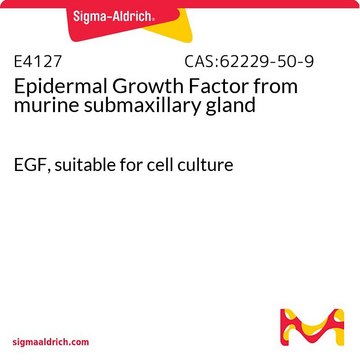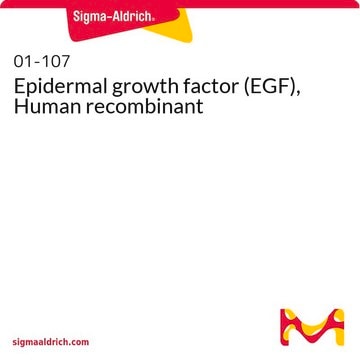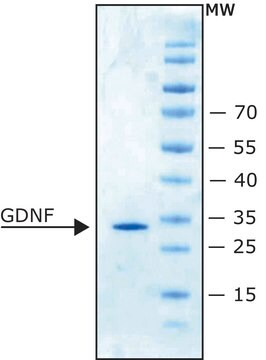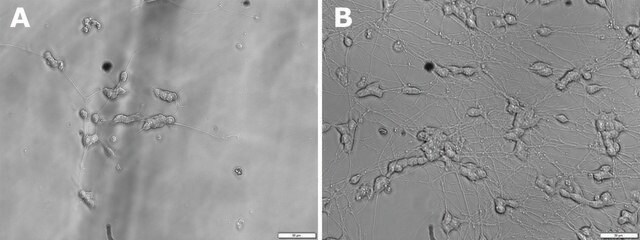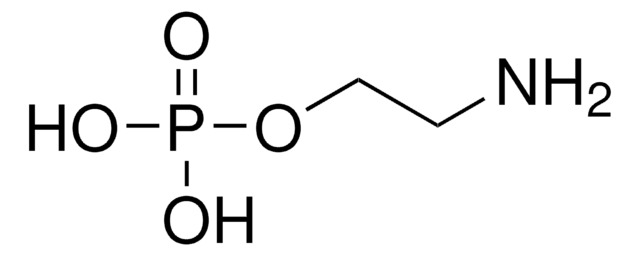324831
EGF human
≥95% (SDS-PAGE), recombinant, expressed in E. coli, solid, suitable for cell culture
Synonim(y):
Naskórkowy czynnik wzrostu, ludzki, rekombinowany, E. coli
Zaloguj sięWyświetlanie cen organizacyjnych i kontraktowych
About This Item
Polecane produkty
Nazwa produktu
EGF, Human, Recombinant, E. coli,
rekombinowane
expressed in E. coli
Poziom jakości
opis
Merck USA index - 14, 3527
Próba
≥95% (SDS-PAGE)
Formularz
solid
producent / nazwa handlowa
Calbiochem®
warunki przechowywania
OK to freeze
zanieczyszczenia
<1.0 EU/μg Endotoxin (EU/μg EGF)
Warunki transportu
ambient
temp. przechowywania
−20°C
Opis ogólny
Recombinant, human epidermal growth factor (54 amino acids) expressed in E. coli. Identical to native human EGF except for an additional N-terminal methionine. Human EGF is 70% homologous to mouse EGF and has been shown to have similar biological activity. Mitogenic for a wide range of ectoderm- and endoderm-derived cells from tissue such as breast, cornea, epidermis, dermis, liver, pancreas, nerve, amnion, and adrenal medulla. Binding of EGF to its 170 kDa transmembrane receptor results in dimerization of the receptor, activation of the intrinsic receptor tyrosine kinase, and initiation of the complex signal transduction cascade that leads to cell proliferation and/or differentiation. Acts as a survival factor in preventing apoptosis.
Działania biochem./fizjol.
ED₅₀ = 100-400 pg/ml as measured by its ability to stimulate the ³H-thymidine incorporation in an EGF-responsive mouse fibroblast cell line, Balb/3T3.
Ostrzeżenie
Toxicity: Standard Handling (A)
Rekonstytucja
Following reconstitution, aliquot and freeze (-20°C or -70°C) for long term storage or refrigerate (4°C) for short-term storage. Avoid freeze/thaw cycles of solutions. Stock solutions are stable for up to 1 month at 4°C or for up to 3 months at -20°C or -70°C.
Reconstitute to a concentration of ≥10 µg/ml in 10 mM acetic acid containing ≥0.1% HSA or BSA.
Inne uwagi
Merlo, G.R., et al. 1995. J. Cell Biol. 128, 1185.
Yoshida, T., et al. 1993. Brain Res. Dev.76, 147.
Rubin, J.S., et al. 1991. Proc. Natl. Acad. Sci. USA88, 415.
Carpenter, G., and Wahl, M.I. 1990. In The Epidermal Growth Factor Family in Peptide Growth Factors and Their Receptors (Sporn, M.B., and Roberts, A.B., eds.) Springer-Verlag, New York, p 69.
Downward, J., et al. 1984. Nature311, 483.
Gray, A., et al. 1983. Nature303, 722.
Scott, J., et al. 1983. Science221, 236.
Cohen, S. 1960. Proc. Natl. Acad. Sci. USA46, 302.
Yoshida, T., et al. 1993. Brain Res. Dev.76, 147.
Rubin, J.S., et al. 1991. Proc. Natl. Acad. Sci. USA88, 415.
Carpenter, G., and Wahl, M.I. 1990. In The Epidermal Growth Factor Family in Peptide Growth Factors and Their Receptors (Sporn, M.B., and Roberts, A.B., eds.) Springer-Verlag, New York, p 69.
Downward, J., et al. 1984. Nature311, 483.
Gray, A., et al. 1983. Nature303, 722.
Scott, J., et al. 1983. Science221, 236.
Cohen, S. 1960. Proc. Natl. Acad. Sci. USA46, 302.
Informacje prawne
CALBIOCHEM is a registered trademark of Merck KGaA, Darmstadt, Germany
Ta strona może zawierać tekst przetłumaczony maszynowo.
Kod klasy składowania
11 - Combustible Solids
Klasa zagrożenia wodnego (WGK)
WGK 2
Certyfikaty analizy (CoA)
Poszukaj Certyfikaty analizy (CoA), wpisując numer partii/serii produktów. Numery serii i partii można znaleźć na etykiecie produktu po słowach „seria” lub „partia”.
Masz już ten produkt?
Dokumenty związane z niedawno zakupionymi produktami zostały zamieszczone w Bibliotece dokumentów.
Klienci oglądali również te produkty
Katarzyna A Ludwik et al.
Cell reports, 32(3), 107931-107931 (2020-07-23)
In response to estrogens, estrogen receptor alpha (ERα), a critical regulator of homeostasis, is degraded through the 26S proteasome. However, despite the continued presence of estrogen before menopause, ERα protein levels are maintained. We discovered that ERK1/2-RSK2 activity oscillates during
Nasz zespół naukowców ma doświadczenie we wszystkich obszarach badań, w tym w naukach przyrodniczych, materiałoznawstwie, syntezie chemicznej, chromatografii, analityce i wielu innych dziedzinach.
Skontaktuj się z zespołem ds. pomocy technicznej




